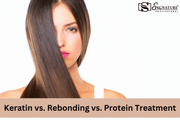
If your hair feels dry, frizzy, or simply refuses to behave, you’re not alone. Many people in Pakistan deal with harsh weather, humidity, pollution, and heat styling that strip the hair’s natural strength.
That’s when professional treatments like keratin, rebonding, and protein come into play. But which one is right for you?
This complete guide breaks down each treatment, their differences, pros and cons, and aftercare tips so you can make a smart choice for healthy, long-lasting results.
What Is a Keratin Treatment?
Keratin is a natural protein that makes your hair strong and shiny. Over time, it gets depleted due to coloring, chemical use, and styling.
A keratin treatment works by restoring that lost protein, sealing it into your strands with heat. It smooths out frizz, reduces puffiness, and adds a natural shine without making your hair stick-straight.
Benefits of Keratin Treatment:
-
Reduces frizz and makes hair soft and manageable.
-
Adds a healthy, reflective shine.
-
Speeds up drying and styling time.
-
Makes hair smoother without completely losing its natural texture.
Best For: People with wavy, frizzy, or dull hair who want smoothness and shine, not poker-straight strands.
If you want to explore keratin-based products that nourish and extend your treatment results, you can view Signature Professional’s Keratin Collection, formulated to deliver salon-quality results at home.
What Is Rebonding?
Rebonding is a permanent straightening process that changes your hair’s structure using chemical relaxers and neutralizers. It breaks your natural hair bonds and reforms them into a straight alignment, giving you sleek, shiny, straight hair that lasts until new growth appears.
Benefits of Hair Rebonding:
-
Delivers pin-straight, glossy hair.
-
Eliminates the need for daily straightening tools.
-
Long-lasting effect that stays until new hair grows out.
However, it comes with some cautions. Rebonding involves strong chemicals that can weaken the hair if done repeatedly or on already damaged hair. It requires regular deep conditioning, proper aftercare, and gentle handling.
Best For: Individuals with very curly or unmanageable hair who prefer a permanent straightened look.
What Is a Protein Treatment?
A protein treatment focuses on repairing and strengthening hair rather than straightening it. It helps fill in weak or porous spots in your hair shaft, improving elasticity, structure, and resilience.
Benefits of Protein Treatment:
-
Repairs chemically damaged or brittle hair.
-
Strengthens weak strands and prevents breakage.
-
Restores elasticity and structure to over-processed hair.
-
Prepares hair for future treatments like keratin or color.
Unlike keratin or rebonding, a protein treatment doesn’t change your hair’s shape or smoothness; it simply rebuilds it from the inside out.
Best For: Color-treated, brittle, or heat-damaged hair that needs restoration before any smoothing or straightening treatment.
Keratin vs. Rebonding vs. Protein – What’s the Difference?
All three treatments serve unique purposes.
Here’s a quick way to understand them without going into technical jargon:
-
Keratin treatment smooths and softens frizz but keeps your natural wave or curl intact.
-
Rebonding permanently straightens the hair for a sleek, uniform look.
-
Protein treatment rebuilds damaged hair and restores its internal strength.
So, while keratin and rebonding focus on the appearance of the hair, protein focuses on the health of the hair.
If your hair is weak and brittle, it’s best to start with protein repair before moving toward smoothing or straightening.
Which Hair Treatment Is Best for You?
Your perfect treatment depends on your hair type, current condition, and goals.
-
If your hair is frizzy but healthy:
→ Go for Keratin Treatment. It gives you smooth, manageable hair without losing your natural texture.
-
If your hair is thick, curly, or hard to manage:
→ Try Rebonding for a sleek, pin-straight finish that lasts for months.
-
If your hair is weak, brittle, or over-processed:
→ Begin with Protein Treatment to strengthen and repair your strands before any chemical process.
-
If you style or color frequently:
→ Combine protein care with mild keratin-infused shampoos and masks for balanced protection.
Aftercare Tips for Long-Lasting Results (Especially in Pakistan)
To keep your treatment looking fresh and your hair healthy:
-
Use sulfate-free shampoos and conditioners to protect the treatment layer.
-
Avoid washing your hair daily 2–3 times per week is ideal.
-
Use a microfiber towel or cotton T-shirt to dry your hair gently.
-
Minimize the use of hot tools and always apply a heat protectant.
-
Deep condition weekly to maintain shine and hydration.
-
Protect hair from sun, humidity, and hard water, which can shorten treatment lifespan.
Following these tips helps your treatment last longer — and keeps your hair looking naturally beautiful in Pakistan’s challenging weather conditions.
Common Mistakes to Avoid
-
Applying multiple chemical treatments back-to-back (like coloring + rebonding).
-
Skipping aftercare or using harsh shampoos.
-
Not doing a strand test before a salon visit.
-
Choosing untrained stylists or low-quality products.
Healthy hair starts with the right process and professional handling — always make sure your stylist uses high-quality, certified products.
Final Thoughts
Each treatment, keratin, rebonding, and protein, has its strengths.
If you want manageability, choose keratin.
If you want permanently straight hair, choose rebonding.
If your hair needs healing, start with protein care.
Before deciding, always evaluate your hair’s health, consult a professional, and choose products designed for your specific needs.
If you’re looking for premium, salon-tested formulas, you can explore Signature Professional’s hair care range here to maintain your treatment results beautifully.
FAQs
1. Which is better: keratin, rebonding, or protein treatment?
It depends on your goal: keratin smooths frizz, rebonding permanently straightens, and protein treatment repairs damaged hair.
2. Does keratin damage hair?
No, keratin doesn’t damage hair when done correctly. It actually adds a protective layer that makes hair smoother and shinier.
3. Which treatment lasts the longest?
Rebonding lasts 6–8 months, keratin about 3–5 months, while protein treatments usually last 4–6 weeks.
4. Can I do keratin or protein treatment at home?
Yes, you can use professional-grade keratin and protein masks at home to maintain your hair between salon sessions.
5. Which treatment is best for frizzy hair in humid weather?
Keratin treatment works best for frizzy or wavy hair, especially in humid climates like Pakistan’s, as it locks in smoothness and shine.









